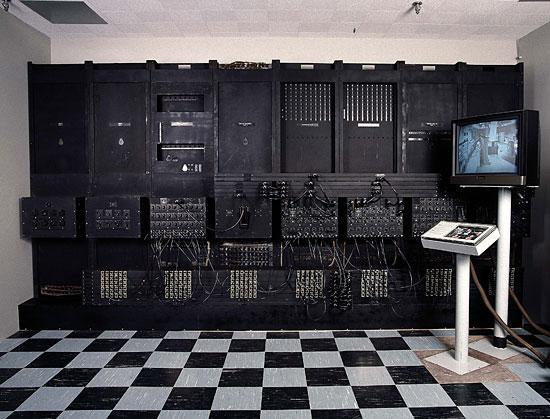The world's first programmable electronic computer weighed 30 tons and consisted of 18,000 vacuum tubes
 Bashny.Net
Bashny.Net

The day February 14 computer scientists say. It is at this day in February 1946, in America, was launched the world's first programmable electronic computer really ENIAC. ENIAC weighed 30 tons and consisted of 18,000 vacuum tubes. ENIAC, compared with a modern PC was just a turtle - its speed was only 5 000 operations per second. The computer worked for nine years until 1955.
Before him, the world existed and earlier models of computers, but they were all experimental variants have not received practical use. If you look at the root, the first computer was the English Babbage's Analytical Engine ...
In 1912 by Russian scientist, mathematician Krylov created the first machine designed to work with differential equations.
Behind her in 1927 in America, in the Massachusetts Institute of Technology invented the first of its kind in the analog computer. In 1938 in Germany, the Berlin University of Technology graduate engineer Konrad Zuse set up his car, later called Z1. Co-author of the invention, called Helmut Schreyer. Z1 was fully mechanical programmable digital computer. Its model was a test. The practical use of it has not received. In the Berlin Technical Museum, you can see it restored version. On its basis Konrad Zuse immediately started to create its modifications Z2.
The original title of his computers were V1 and V2. In German, it sounded like "the V 1" and "2 Fau." The resulting confusion was soon with the names of German rockets led to the renaming computers Konrad Zuse.
They were called the Z1 and Z2. In 1941, Konrad Zuse creates the following computing machine Z3. She had already almost all available in modern computer properties.
In 1942, the American University of Iowa John Atanasoff and his graduate student co Clifford Berry develops which was the revolutionary electronic digital computer (Atanasoff-Berry Computer -ABC). They proceed to its installation, but Atanasova drafted into the army and the installation of ABC was never completed. Unfinished ABC saw John Mauchly and impressed started to create their computer Electronic Numerical Integrator And Computer - abbreviated as ENIAC. In nachale1943 year in America was successfully tested another computer Mark I. It was designed to perform complex ballistic calculations of the US Navy. Strictly speaking the Mark I computer was not yet. In kontse1943, the British launched their computing machine Colossus. It also was not a computer. The machine has a narrow purpose and successfully coped with decoding the secret codes of the Third Reich. In 1944, already known Konrad Zuse created the following, even faster version of its PC - Z4.
But admitted the first year of the creation of the mainframe began in 1946, when America gained ENIAC. ENIAC was the first real performing practical tasks computers. The ENIAC computer was used a binary system of calculation, which took over from it all modern computers.
He razraboatyvalsya commissioned by the Army to address one of the pressing problems of wartime. In artillery and aircraft were used in the bombing ballistic tables. For their preparation worked whole departments calculators. They used slide rules and therefore the number of calculations performed by them and their performance did not meet the huge needs of the army in wartime. In early 1943, the army turned to cybernetics to develop a conceptually new programmable computing device. Thus was created a computer ENIAC.
Source: www.vmireinteresnogo.com
via factroom.ru
Tags
See also
The world's largest flying boat
As a "Matilda" was carrying the weight of the turbine 308 tons
To live in the present and not false this is the main practice
Biggest Plane Hughes H-4 Hercules
Hughes H-4 Hercules. Aircraft giant genius designer
Athlete budged train weighing 120 tons
Let me go
Tool that opens the door to the future of electronic music
Konrad Zuse: a dreamer, who created the first computer
Pictures at an Exhibition. Meet the first unmanned drone taxi EHang 184

















